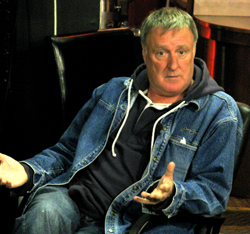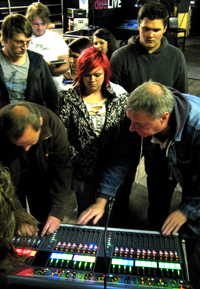![]() Mixing anecdote with hard-won wisdom is something Robbie McGrath does as effortlessly as mixing the biggest bands of the past 40 years.
Mixing anecdote with hard-won wisdom is something Robbie McGrath does as effortlessly as mixing the biggest bands of the past 40 years.
Today his audience is a group of students that he is encouraging to become the next generation of live sound engineers. But where McGrath is upfront about getting into the business by being in the right place at the right time, they don't yet realise how lucky they are...
Let me show you a mansion…
‘I grew up in Dublin and I had a van,’ he opens, ‘and from there it was straight to Madison Square Garden. No looking back.
 ‘Live sound is a great job and it will give you a fantastic lifestyle but you need to pay your ticket. Never sell yourself short and never work for nothing,’ he warns. Throw in a few very well pitched drugs references and he has the full attention of the students. Who else could have had Keith Richards tell him that ‘it’s all about moderation’? They quickly realise that this is someone they can really learn from.
‘Live sound is a great job and it will give you a fantastic lifestyle but you need to pay your ticket. Never sell yourself short and never work for nothing,’ he warns. Throw in a few very well pitched drugs references and he has the full attention of the students. Who else could have had Keith Richards tell him that ‘it’s all about moderation’? They quickly realise that this is someone they can really learn from.
The big Irishman says he would have loved to mix for the notorious Rat Pack, when Frank Sinatra, Sammy Davis Jr, Dean Martin, Joey Bishop and Peter Lawford were at their peak. And you have to guess that he would have enjoyed a ringside seat to 1960s Las Vegas as much as the music. Instead, he can lay claim to a list of artists that places him comfortably in the World Top Ten FOH engineers – Thin Lizzy, Boomtown Rats, Lenny Kravitz, The Stranglers, The Sex Pistols, Queen, U2 and three world tours with The Rolling Stones among them. Currently, he has the hot seat with Kasabian.
His manner with the students at UK college dBs Music is light and easy, but his message is the accumulation of 30 years spent behind the desk and in the company of some of the most notorious hedonists of modern times. In addition to which, live sound is riding out a succession of waves created by breakthrough technologies and seismic shifts in music demographics. Some would call it a crisis.
Again, it seems, McGrath is a man in the right place at the right time. This time, however, he’s helping to insure the future of live music. And he’s quickly onto the interpersonal skills that underpin any entertainment industry. He says he’s ‘useless at faking it’, and that it’s essential to enjoy the music being played and to be a part of the team – even if you’re only noticed when things aren’t going so well. ‘Part of your job is to protect your artist,’ he advises. ‘When they are sounding bad, if their playing or tuning is off, you have to help them. Their performance outweighs yours.’
Supporting cast
Their questions prove that there’s more to the dBs students than the mindless fame-seeking that has seduced many of their generation. And McGrath is well supported by Allen & Heath Design Specification Manager Carey Davis and ex-Midas/Meyer Sound man, Dave Wiggins. Having given his own talk earlier, the Production Services Association’s Andy Lenthall is also on hand for matters of event production.
‘I was mad for the early digital stuff but I couldn’t get a good drum or vocal sound out of it with a big system,’ McGrath says. ‘The dynamic range just wasn’t close to analogue. But the technology today is brilliant. We used to have to use stuff that should never have been made…’
 Between them, McGrath and Wiggins navigate their way through analogue and digital mixing, line array vs point source and other important issues.
Between them, McGrath and Wiggins navigate their way through analogue and digital mixing, line array vs point source and other important issues.
Key to bridging the gap between the sound of analogue and the power of digital is distortion. It lives in dark corners and digital needs to seek it out. Davies knows this and it happy to talk. Neither are the convenience and ‘green’ credentials of digital recall as billed, since plug-ins readily undermine compatibility. And there’s still no replacement for analogue’s ability to offer familiar layouts and working practices – whether at the mix position or in the racks driving the speaker systems.
When it comes to desks, McGrath is still basically an analogue man but the conversation between sound engineer, desk designer and future users is portentous, and indicates a likely future brokered by open exchange. If there is a crisis in audio education – specifically for live sound – then there is a lesson here.
The discussion is honest and informed. But best of all, it is inclusive. Not only are the students listening to established voices of the industry, their own voices are being heard.
Nor is the session limited to anecdote and technology, as McGrath is well placed to give real-world warnings regarding hearing protection and wild work cycles. In fact, taken in conjunction with the ground covered by dBs Music’s courses, this provided answers to many of the issues raised by Fast-and-Wide’s Audio Boy recently.
And perhaps there is a sense of relief to McGrath’s talk.
In a 2003 interview with Live Sound International, he remarked: ‘There are not a lot of young people coming into this business like they used to, because it’s not as attractive as it used to be.’
But the live scene is now thriving and there is a generation of sound engineers and hire companies that recognise new blood is essential. And here they are, being welcomed to play an early part. And about 20 per cent of them are girls.

